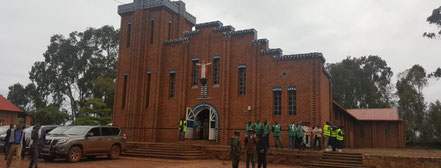what can i see at nyarubuye genocide memorial in rwanda in 2024

Nyarubuye Genocide memorial is situated in Kirehe district, 140 km east of Kigali, close to Kibungo town, and near the Tanzania border. It is positioned just next to the nuns' convent of the Catholics of Rwanda and the school that was run by the Benebikira sisters. click here to view mountain gorilla trekking safaris
This site is home to approximately 20,000 Rwanda’s Tutsis and average Hutus who were killed while they were trying to escape to Tanzania, seeking shelter or refuge in the Catholic Church.
Nyarubuye Genocide Memorial victims were murdered with strong disastrous weapons such as machetes, clubs, automatic weapons, and spears. The nuns' convent is home to clothes, shoes, and the body remains of the genocide victims while the school was reformed in the local community school. DEVINE AFRICAN SAFARIS make memories in Rwanda
Nyarubuye Genocide Memorial is situated just 35 kilometers from the southern town of Kibungo in Kirehe district, along the eastern province. The Nyarubuye genocide memorial site is the former Catholic church, nunnery, and its accompanying school.
The buildings of the Benebikira Sisters are a reminder of the appalling murder that took place on the 14th and 15th of April 1994 during the Genocide against the Tutsi, where over 20,000 people were murdered innocently.
A radio station announced on April 7, 1994, that residents should stay inside their houses. Tutsis arrived in Nyarubuye the next day, having traveled from different locations where the killings had already begun. Most of these individuals went to Nyarubuye Church, but some visited nearby family and friends.
Testimonies gathered after the 1994 genocide indicate that both Hutus and Tutsis in Nyarubuye sheltered a large number of newly arriving Tutsis. The people living there were intent on making sure that Nyarubuye would not become the scene of massacres that they had heard were already taking place in Rukira.
Some residents of Nyarubuye started working with the Interahamwe and gendarmes and taking part in killings when gendarmes from the neighboring Nasho district encouraged Hutus to kill Tutsis.
It took many days for the militia to launch an attack, but when they did, they first targeted the homes of Tutsis. While some Tutsis were slaughtered, others managed to flee and make their way to the Nyarubuye Catholic Church. Some more tried to flee to Tanzania, but many were stopped while circumnavigating the border with Rusumo and forced to return to Nyarubuye by the Interahamwe. To ensure the safety of all Tutsis, Sylvestre Gacumbitsi, the commune burgomaster, recruited a group of people to escort them to the parish church.
The number of Tutsis visiting the church had increased significantly by April 12th, with many coming from the communes of Rukira, Rusumo, Birenga, Kigarama, and Rukara. An estimate of 35,000 Tutsis was found during a census conducted on April 13 to determine the population of Tutsis in the church and its environs.
Tutsis thought the purpose of the counting was to assist the burgomaster in estimating the amount of support that would be needed. Still, in reality, the numbers were utilized to calculate the exact number of murders that would be required.
That night, militia and gendarmes assaulted from different angles, brandishing firearms, machetes, swords, grenades, and other customary weapons. After encircling the location, they began an assault on the church, methodically eliminating Tutsis over several hours. Gendarmes with weapons and grenades led the way first, followed by a sizable contingent of Interahamwe murderers.
The next day, the communal judge, Evariste Rubanguka, and the burgomaster ordered capsicum to be sprayed on the body piles to see if any of the corpses had survived. It was observed that Evariste was using the capsicum spray himself.
Even in the context of the entire genocide, Nyarubuye had notably high levels of violence. Girls were raped in the nuns' lavatory, and pregnant women had their stomachs opened before being killed, with the fetus being tossed into the toilets. They would first pierce the girls and ladies through the vagina with pointed wooden items before killing some of them. Youngsters were killed instantly when they were slammed up against the kitchen wall.
Other symbolic acts were intended to dehumanize individuals who were going to die. Because the Virgin Mary monument "looked like a Tutsi," it was dismantled. Destroying the monument signified that "God had abandoned the Tutsi," symbolically speaking.
"May the blood of Tutsi become the milk they are fond of," the assassins cried as they chopped off the heads of the Tutsis with their machetes and poured the blood into an imivure, a customary container. Out of the 35,000 people inside the church, only 18 made it out alive.
